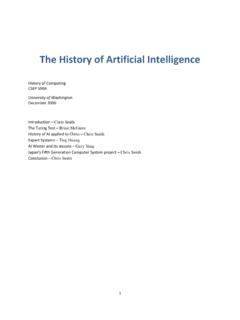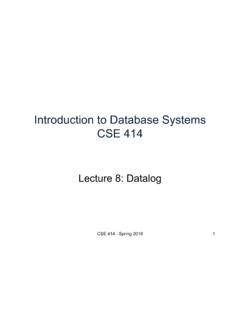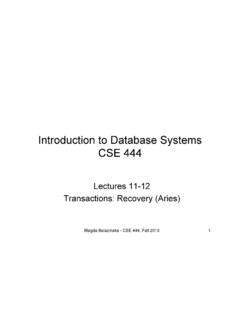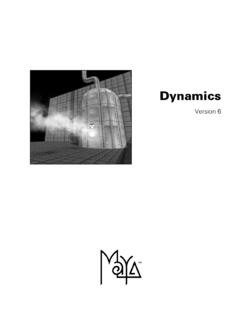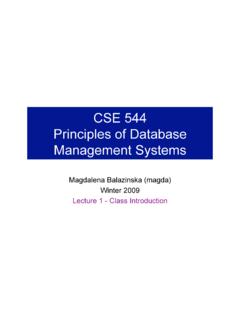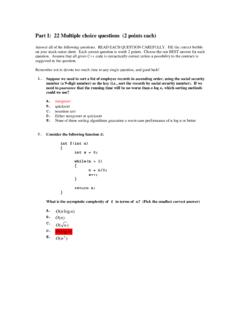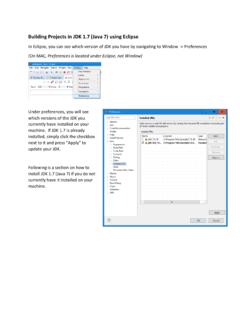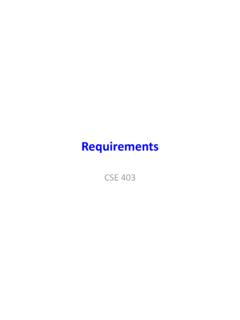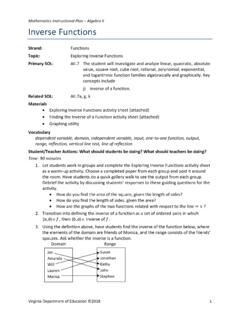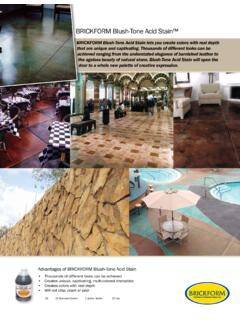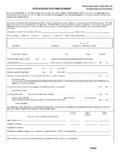Transcription of Lecture 6 Features and Image Matching
1 Lecture 6 Features and Image Matching UW CSE vision facultySuppose you want to create a panoramaFrom Matthew BrownWhat is the first step?Need to match portions of imagesSolution: Match Image regions using local featuresAnother exampleby Diva Sianby swashfordHarder caseby Diva Sianby scgbtHarder still?NASA Mars Rover imagesNASA Mars Rover imageswith SIFT feature matchesFigure by Noah SnavelyAnswer below (look for tiny colored ) Features can also be used for object recognitionFeature DescriptorsWhy local featuresLocality Features are local, so robust to occlusion and clutterDistinctiveness: can differentiate a large database of objectsQuantity hundreds or thousands in a single imageEfficiency real-time performance achievableGenerality exploit different types of Features in different situationsApplications Features are used for.
2 Image alignment ( , panoramic mosaics) Object recognition 3D reconstruction ( , stereo) Motion tracking Indexing and content-based retrieval Robot navigation ..Want Features that are invariant to transformations geometric invariance: translation, rotation, scale photometric invariance: brightness, exposure, ..Feature DescriptorsWhat about edges? Edges can be invariant to brightness changes but typically not invariant to other transformationsWhat makes a good feature? Want uniqueness Leads to unambiguous matches in other images Look for interest points : Image regions that are unusual How to define unusual ?
3 Finding interest points in an imageSuppose we only consider a small window of pixels What defines whether a feature is a good or bad candidate?Slide adapted form Darya Frolova, Denis Simakov, Weizmann Institute. flat region:no change in all directions edge : no change along the edge direction corner :significant change in all directions, , even the minimum change is largeHow does the window change when you shift it?Slide adapted form Darya Frolova, Denis Simakov, Weizmann locations such that the minimum change caused by shifting the window in any direction is largeFinding interest points in an imageConsider shifting the window Wby (u,v) how do the pixels in Wchange?
4 Compare each pixel before and after using the sum of squared differences (SSD) this defines an SSD error E(u,v):Finding interest points (Feature Detection): the mathWTaylor Series expansion of I:If the motion (u,v) is small, then first order approx. is goodPlugging this into the formula on the previous motion assumptionFeature detection: the mathWFeature detection: the mathThis can be rewritten:For the example above: You can move the center of the green window to anywhere on the blue unit circle How do we find directions that will result in the largest and smallest E values? Find these directions by looking at the eigenvectors ofH vuIIIIII vuvuEWyxyyxyxx ] [),(),(22 Quick eigenvalue/eigenvector reviewThe eigenvectorsof a matrix Aare the vectors xthat satisfy:The scalar is the eigenvaluecorresponding to x The eigenvalues are found by solving: In our case, A= His a 2x2 matrix, so we have The solution:Once you know , you find xby solvingx1x2 Feature detection: the mathEigenvaluesand eigenvectors of H Capture shifts with the smallest and largest change (E value) x+= direction of largestincrease in E.
5 += amount of increase in direction x+ x-= direction of smallestincrease in E. -= amount of increase in direction x-x-x+ vuIIIIII vuvuEWyxyyxyxx ] [),(),(22 Feature detection: the mathHow are +,x+, -, and x-relevant for feature detection? +>> - +>> - +and -are both large;E increases in all directions 1 2 ExampleFeature detection: the mathWant E(u,v)to be largein alldirections the minimumof E(u,v)should be large over all unit vectors [u v] this minimum is given by the smaller eigenvalue -of H Look for large values of -Feature detection (interest point detection) summaryHere s what you do Compute the gradient at each point in the Image Create the Hmatrix from the entries in the gradient Compute the eigenvalues Find points with large -( , -> threshold)
6 Choose points where -is a local maximum as interest pointsFeature detection summaryHere s what you do Compute the gradient at each point in the Image Create the Hmatrix from the entries in the gradient Compute the eigenvalues. Find points with large response ( -> threshold) Choose those points where -is a local maximum as Features (interest points)The Harris operator -is a variant of the Harris operator for feature detection det is the determinant; trace = sum of diagonal elements of a matrix Very similar to -but less expensive (no eigenvalue computation) Called the Harris Corner Detector or Harris Operator Most popular among all detectors222211211222112)( trace)(det )()()(HkHhhkhhhhkfHarris =+ =+ = + + The Harris operatorHarris operatorHarris detector examplefHarrisvalue (red high, blue low)Threshold (fHarris> threshold value) Find local maxima of fHarrisHarris Features (in red)
7 Invariance of Eigenvalue-based feature detectorsSuppose you rotatethe Image by some angle Will you still pick up the same feature points? Yes (since eigenvalues remain the same)What if you change the brightness? Will you still pick up the same feature points? Mostly yes (uses gradients which involve pixel differences)Scale? No!Scale invariant interest point detectionSuppose you re looking for corners using fHarrisKey idea:Find scale that gives local maximum of fHarris Generate copies of Image at multiple scales by convolving with Gaussians of different and using a pyramid Find local maxima points by comparing to neighboring points at current and adjacent scales Each interest point is a local maximum in both position and scaleSee SIFT paper on line for detailsFeature descriptorsWe know how to detect good interest pointsNext question: How to match Image regions around interest points?
8 Answer:Need feature descriptors?Feature descriptorsLots of possibilities (this is a popular research area) Simple option: match square windows of pixels around the point State of the art approach: SIFT David Lowe, UBC ~lowe/keypoints/How to achieve invariance in Image matchingTwo steps:1. Make sure your feature detectoris invariant Harris is invariant to translation and rotation Scale is trickier common approach is to detect Features at many scales using a Gaussian pyramid ( , MOPS) More sophisticated methods find the best scale to represent each feature ( , SIFT)2. Design an invariant feature descriptor A descriptor captures the intensity information in a region around the detected feature point The simplest descriptor: a square window of pixels What s this invariant to?
9 Let s look at some better dominant orientation of the Image patch This is given by x+, the eigenvector of Hcorresponding to + + is the largereigenvalue Rotate the patch according to this angleRotation invariance for feature descriptorsFigure by Matthew BrownTake 40x40 square window around detected feature Scale to 1/5 size (using prefiltering) to get 8x8 square window Rotate to horizontal Normalize the window by subtracting the mean, dividing by the standard deviation in the windowCSE 576: Computer VisionMultiscaleOriented PatcheS descriptor8 pixels40 pixelsAdapted from slide by Matthew BrownDetections at multiple scalesBasic idea.
10 Take 16x16 square window around detected interest point (8x8 shown below) Compute edge orientation (angle of the gradient minus 90 ) for each pixel Throw out weak edges (threshold gradient magnitude) Create histogram of surviving edge orientations (8 bins)Scale Invariant Feature TransformAdapted from slide by David Lowe02 angle histogramSIFT descriptorFull version Divide the 16x16 window into a 4x4 grid of cells (8x8 window and 2x2 grid shown below for simplicity) Compute an orientation histogram for each cell 16 cells * 8 orientations = 128 dimensional descriptorAdapted from slide by David LoweProperties of SIFT-based matchingExtraordinarily robust Matching technique Can handle changes in viewpoint Up to about 60 degree out of plane rotation Can handle significant changes in illumination: Sometimes even day vs.

